Crop Rotation: Enhancing Soil Health and Productivity
Crop Rotation: Enhancing Soil Health and Productivity
A few years ago, I didn’t give much thought to what was happening beneath my boots. Soil was soil, brown, dusty, and hopefully fertile. If a crop failed, I blamed the weather or bad luck. But things have changed. These days, I find myself obsessing over pH levels, nitrogen content, and microbial activity like a scientist on a discovery mission. And the reason? Crop regulation, powered by smart tech, is turning out to be one of the most important tools in the modern farmer’s toolkit.
It’s not as flashy as drones or AI, but when it comes to crop rotation and long-term productivity, nothing matters more than the ground we grow in.
The Foundation Beneath Our Feet
Crop rotation simply means managing the health, composition, and balance of soil to keep it productive over time. Sounds basic, but it’s revolutionary when done right. Why? Because soil isn’t just dirt, it’s a living ecosystem. And like any ecosystem, it needs care, balance, and feedback.
Enter crop rotation, the age-old practice of changing what you grow in a field season by season. It sounds simple, but effective rotation depends entirely on understanding what your soil needs, what it’s been through, and how it’s recovering.
From Guesswork to Ground Truth
In the past, farmers rotated crops based on tradition or intuition: “This field had maize last year, so let’s do pulses this year.” That still works, sometimes. But in a world of shrinking margins and rising unpredictability, guesswork doesn’t cut it anymore.
Today, IoT sensors and smart soil diagnostics let farmers measure what’s happening underground in real time. Moisture, pH, electrical conductivity, organic matter, these aren’t just stats; they’re indicators of what your soil craves next.
Take Anita, a rice and soybean farmer in Tamil Nadu, India. After years of growing the same crops, her yields began to drop. Rather than doubling down on fertilizer, she started using a soil testing app connected to a handheld IoT probe. What she found surprised her: the soil was acidic, low in nitrogen, and biologically exhausted. With this data, she adjusted her rotation plan, introducing legumes to fix nitrogen and planting cover crops to replenish organic matter. A year later, her fields are healthier, and her yields are back up.
Rotation Without Regulation is Just Roulette
Crop rotation isn’t just about variety, it’s about recovery. One crop might deplete potassium; another might restore it. Some attract pests, others deter them. But unless you know what’s happening in your soil, rotation becomes a gamble instead of a strategy.
That’s where regulation steps in. By monitoring soil health regularly, farmers can time rotations with surgical precision. It’s the difference between farming reactively and farming intelligently.
Climate Chaos Meets Soil Science
Climate change is throwing curve-balls at farmers everywhere. Unseasonal rains, longer dry spells, rising soil salinity, it’s tough out there. But regulated soil gives farmers a fighting chance. With the right data, they can select crops that not only survive but support the soil for the next cycle.
For example, in semi-arid regions, rotating with drought-resistant crops while maintaining soil cover reduces erosion, conserves moisture, and supports long-term fertility. It’s not just about surviving one season, it’s about building a system that lasts.
The Tech Helping Roots Go Deeper
We’re seeing an explosion of tools that support soil regulation and smarter rotation:
Portable IoT soil sensors: Affordable probes that give real-time nutrient readings.
AI-driven crop planners: Apps that suggest rotation plans based on soil conditions and past yield data.
Smart irrigation systems: Tailored watering based on what specific crops and soil types need.
Soil carbon tracking: Tools that help farmers monitor and increase soil organic carbon, improving structure and fertility.
These aren’t luxuries anymore. They’re necessities, especially for smallholder farmers who need to make every inch of land work harder and smarter.
Final Thoughts
Crop rotation isn’t just where crops grow; it’s where farming begins. And as we look for feed more people on less land, understanding and regulating soil health isn’t optional; it’s essential.
Smart crop rotation starts with smart soil. And thanks to the marriage of tradition and technology, farmers are becoming not just cultivators of crops, but stewards of the earth beneath them.
As someone once said, “Don’t treat soil like dirt.” Because when we listen to the land, it tells us exactly what to do next.

